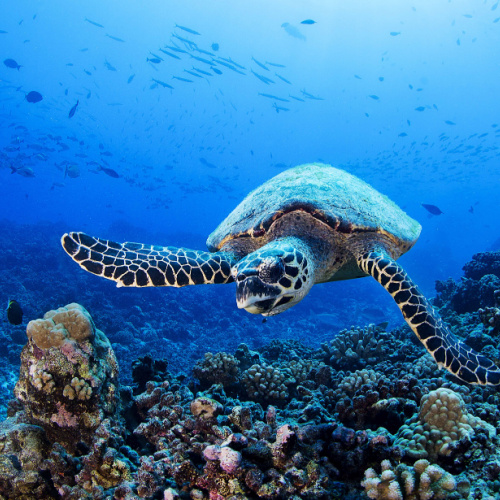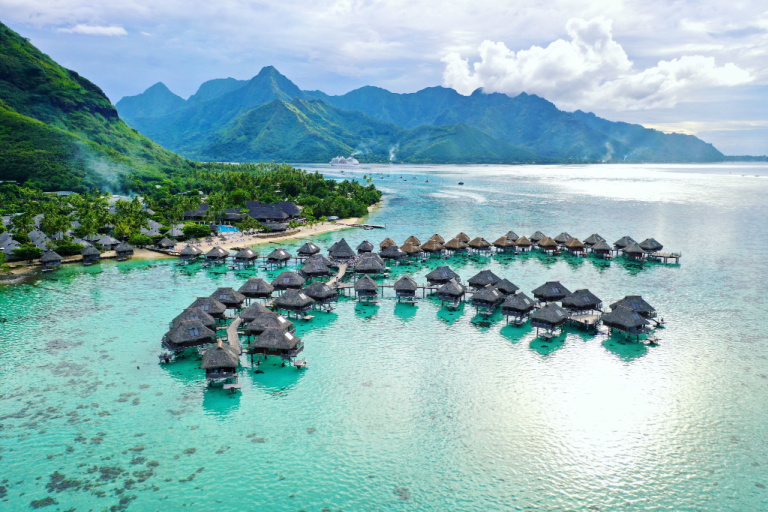
J.S. Lamy/Shutterstock
When Is the Best Time to Visit French Polynesia?
The best time to visit French Polynesia is during the dry season, which runs from May to October. During these months, the weather is generally sunny and warm, with little rainfall. This makes it ideal for enjoying the country’s many outdoor activities, such as swimming, sunbathing, snorkeling, and diving.
Benefits of visiting French Polynesia during the dry season:
- Sunny weather: French Polynesia has a tropical climate, with warm temperatures and humidity year-round. However, the dry season offers the best chance of sunny weather, with less rainfall and more sunshine. This makes it ideal for enjoying the country’s many outdoor attractions.
- Clear waters: The dry season is also the best time to visit French Polynesia for its clear waters. This is because there is less rainfall and runoff during this time of year, which means that the water is more visible and there is less chance of algae blooms.
- Fewer crowds: French Polynesia is a popular tourist destination, but the dry season is less crowded than the peak summer season. This means you’ll be able to enjoy the country’s attractions without having to deal with large crowds.
- Lower prices: Prices for flights, accommodation, and activities are generally lower during the dry season than during the peak summer season. This means you can save money on your trip without having to sacrifice quality.
Specific examples of how you can enjoy the most of French Polynesia during the dry season:
- May to June: The weather in May and June is typically sunny and warm, with occasional showers. This is a great time to visit the Society Islands, including Tahiti, Moorea, and Bora Bora. You can go swimming, snorkeling, diving, fishing, and hiking.
- July to October: The weather in July to October is also typically sunny and warm, with occasional showers. This is a great time to visit the Tuamotu Islands, the Marquesas Islands, and the Austral Islands. You can go sailing, kayaking, and explore traditional villages.
While it is possible to visit French Polynesia at any time of year, the dry season of May to October offers the best combination of sunny weather, clear waters, fewer crowds, and lower prices.
 Average Temperatures by Month
Average Temperatures by Month
|
Jan |
Feb |
Mar |
Apr |
May |
Jun |
Jul |
Aug |
Sep |
Oct |
Nov |
Dec |
| Fahrenheit |
87°
|
87°
|
87°
|
86°
|
85°
|
84°
|
84°
|
84°
|
84°
|
85°
|
86°
|
86°
|
| Celsius |
31°
|
31°
|
31°
|
30°
|
29°
|
29°
|
29°
|
29°
|
29°
|
30°
|
30°
|
30°
|
Climate in French Polynesia
Summer Season in French Polynesia
Often considered as 'summer' in French Polynesia, the wet season is characterized by warmer temperatures and high humidity, with frequent and sometimes heavy rainfall. This period also coincides with the cyclone season, although cyclones are relatively rare. The wet season's warm temperatures and occasional showers bring lush greenery and vibrant landscapes, but the increased humidity and rain can affect some outdoor activities.
Rainy Season in French Polynesia
The dry season, often referred to as 'winter' in French Polynesia, brings cooler and drier weather, with lower humidity and less rainfall. This is the most popular time for tourists, offering ideal conditions for swimming, snorkeling, diving, and exploring the islands. The weather is generally sunny and pleasant, making it perfect for beach activities and enjoying the natural beauty of the islands.
Winter Season in French Polynesia
In the traditional sense, French Polynesia does not experience a winter with cold weather. The closest to 'winter' is the dry season, where the temperatures are slightly cooler compared to the wet season, but the climate remains warm and tropical, suitable for beach and water activities. The concept of winter, as understood in temperate regions, does not apply to French Polynesia's tropical climate.
Our Recommendations
| Destination |
Jan |
Feb |
Mar |
Apr |
May |
Jun |
Jul |
Aug |
Sep |
Oct |
Nov |
Dec |
| French Polynesia |
 |
 |
 |
 |
 |
 |
 |
 |
 |
 |
 |
 |






